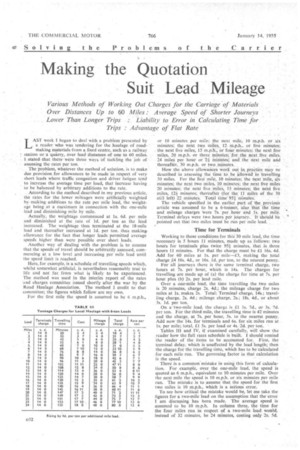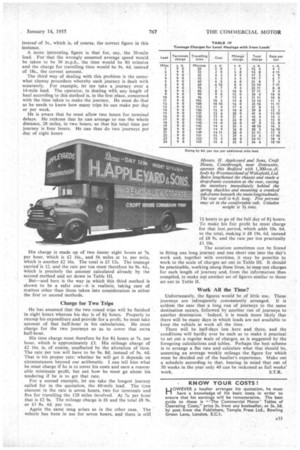Making the Quotation Suit Lead Mileage
Page 72

Page 79

If you've noticed an error in this article please click here to report it so we can fix it.
Various Methods of Working Out Charges for the Carriage of Materials Over Distances Up to 60 Miles : Average Speed of Shorter Journeys . Lower Than Longer Trips : Liability to Error in Calculating Time for Trips : Advantage of Flat Rate LAST week I began to deal with a problem presented by a reader who was tendering for the haulage of road
• making materials from a fixed centre, such as a railway station or a quarry, Over lead distances of one to 60 miles. . 1 stated-that there were three ways 'of tackling the job of • assessing the rates per ton. • The problem, whatever the method of solution, is to make doe provision for allowances to be made in respect of very short leads where traffic congestion and driver fatigue tend • to increase the average time per load, that increase having to be balanced by arbitrary additions to the rate.
According to the method described in my previous article, the rates for the lower mileages were artificially weighted bymaking additions to the rate per mile lead, the weightage being at a maximum in connection with the one-mile lead and diminishing mile by mile.
Actually, the weightage commenced at Is. 6d. per mile and diminished at the rate of Id. per ton as the lead increased. The weightage thus terminated at the 18-mile lead and thereafter increased at id. per ton. thus making allowance for the fact that longer leads permitted average speeds higher than were possible over short leads.
Another way of dealing with the problem is to assume that the speeds of travel should be arbitrarily assessed, commencing at a low level and increasing per mile lead until the speed limit is reached.
Here, for example, is a schedule of travelling speeds which, whilst somewhat artificial, is nevertheless reasonably true to life and not far, from what is likely to be experienced. The method was used in the interim report of the rates and charges committee issued shortly after the war by the Road Haulage Association. The method I credit to that committee; the figures which follow are my own.
For the first mile the speed is assumed to be 6 m.p.h.,
or 10 minutes per mile; the next mile. 10 m.p.h. or six minutes; the next two miles; 12 m.p.h., or five minutes; the next five miles, 15 m.p.h., or four minutes; the next five miles, 20. m.p.h. or three minutes; for the next five miles, 24 miles per hour or. -24 minutes; and the next mile and thereafter, 30 m.p.h. or two minutes.
How the above allowances work out in practice may oe described in assessing the time to be "allowed in travelling 30 miles. For the first milt, 10 minutes; the next mile, six minutes; the next two 'miles, 10. minutes; the next five miles
20 minutes; the next five miles, 15 minutes the next five. miles, 124 minutes; thereafter (for the II miles of the 30 still left) 22 minutes. Total time' 951 minutes: The vehicle specified in the earlier part of the previous article was assumed to be a ti-tanner, also that 'the time and mileage charges were 7s. per hour and is. per mile. Terminal delays were two hours per journey. It should be pointed out that two miles 'must be run per mile lead. .
Time for Terminals Working to those conditions for ttii.30 mile lead, the time necessary is 5 hours II minutes, made up as.follows: two
hours for terminals plus twice 95i minutes, that is .three hours 11 minutes. For that the charge must he LX 16s. 4d. Add for 60 miles at Is. per mile-€3, making the total charge £4 16s. 4d., or 16s. id. per ton, to the nearest penny.
For all journeys there is the same terminal charge, two hours at 7s. per hour, which is 14s. The charges for travelling are made up of (a) the charge for time at 7s. per hour plus (b) 2s. per lead mile.
Over a one-mile lead, the time travelling the two miles is 20 minutes, charge 2s. 4d.; the mileage charge for two miles at Is. makes 2s. Total: Terminal charge, 14s.; travelling charge, 2s. 4d.; mileage charge, 2s.; 18s. 4d., or about 3s. Id. per ton.
On a'two-mile lead, the charge. is £1 Is, 7d., or 3s. 7d. per ton. For the third mile, the travelling time is 42 minutes and the charge, at 7s. per hour, 5s. to the nearest penny. Add now the 14s. for terminals and 6s. for six miles run at Is: per mile; total, £1 5s. per load or 4s. 2d. per ton. • Tables III and IV, if examined carefully, will show the reader how the full rates schedule is built. I should remind the reader of the items to be accOunted for. First, the terminal delay, which is unaffected by the lead length; then the charge for the travelling tirrie, which has to he calculated for each mile run. The governing factor in that calculation is the speed.
There is a common mistake in using this form of calculation. For example, over the one-mile lead, the speed is quoted as 6 m.p.h., equivalent to ICI minutes per mile. Over the next mile the speed is 10 m.p.h. or six minutes per mile run. The mistake is to assume that the speed for the first two miles is 10 m.p.h., which is a Serious error.
To see bow critical the mistake would be, let me take the figures for a two-mile lead on the assumption that the error I am discussing has been made. The average speed is assumed to be 10 m.p.h. In column three, the time for the 'four miles run in respect of a two-mile lead would, instead of 32 minutes, be 24 minutes, costing only 2s. 5d. instead of 3s., which is, of course, the correct figure in this instance.
A more interesting figure is that for, say, the 20-mile lead. For that the wrongly assumed average speed would be taken to be 30 m.p.h., the time would be 80 minutes and the charge for travelling time would be 9s. 4d. instead of I8s., the correct amount.
The third way of dealing with this problem is the somewhat clumsy procedure whereby each journey is dealt with separately, For example, let me take a journey over a 14-mile lead. The operator, in dealing with any length of haul according to this method is, in the first place, concerned with the time taken to make the journey. He must do that as he needs to know how many trips he can make per day or per week.
Fie is aware that he must allow two hours for terminal delays. He reckons that he can arrange to run the whole distance, 28 miles, in two hours, so that his total time per journey is four hours. He can thus do two journeys per day of eight hours
His charge is made up of two items: eight hours at 7s. per hour. which is £2 16s., and 56 miles at Is. per mile, which is another £2 16s, The total is £5 12s. The tonnage carried is 12, and the rate per ton must therefore be 9s. 4d., which is precisely the amount calculated already by the second method and set down in Table III.
But—and here is the way in which this third method is shown to be a safer one—it is realistic, taking care of matters other than those taken into consideration in either the first or second methods.
Charge for Two Trips
He has assumed that the two round trips will be finished in eight hours whereas his day is of 81 hours, Properly to recoup his expenditure and provide for a profit, he must take account of that half-hour in his calculations. He must charge for the two journeys so as to cover that extra half-hour.
His time charge must therefore be for 8+ hours at 7s. per hour, which is approximately £3. His mileage charge of £2 16s. is, of course, unaffected by the alteration of time. The rate per ton will have to be 9s. ad. instead of 9s. 4d. That is his proper rate: whether he will get it depends on circumstances beyond our arithmetic. I can tell him what he must charge if he is to cover his costs and earn a reasonable minimum profit, but not how he must go about his tendering if he is to get that rate.
For a second example, let me take the longest journey called for in the quotation, the 60-mile lead. The time element in the rate is seven hours, two for terminals and five for travelling the 120 miles involved. At 7s, per hour that is £2 9s. The mileage charge is £6 and the total £8 4s. or El 85. 4d. per ton.
Again the same snag arises as in the other case. The vehicle has been in use for seven hours, and there is still 11 hours to go of the full day of 8j hours. To make his fair profit he must charge for that lost period, which adds 10s. 6d. to the total, making it £8 19s. 6d. instead of £8 9s. and the rate per ton practically £1 10s.
The solution sometimes can be found in fitting one long journey and one short one into the day's work and, together with overtime, it may be possible to work to the scale of charges set out in Table III. It should be practicable, working along these lines, to map out charges for each length of journey and, from the information thus compiled, to make out another set of figures similar to those set out in Table IT.
Work All the Time?
Unfortunately, the figures would be of little use. These journeys are infrequently conveniently arranged. It is seldom the case that a long run of journeys to the same destination occurs, followed by another run of journeys to another destination. Indeed, it is much more likely that there will be many days in which loads are not available to keep the vehicle at work all the time.
There will be half-days lost here and there, and the conditions will hardly ever be such as to make it practical to set out a regular cale of charges, as is suggested by the foregoing calculations and tables. Perhaps the best scheme is to arrange a flat rate and calculate what that should be, assuming an average weekly mileage the figure for which must be decided out of the haulier's experience. Make out a schedule according to that, bearing in mind that out of 50 weeks in the year only 40 can be reckoned as full weeks' work. S.T.R.
















































































































